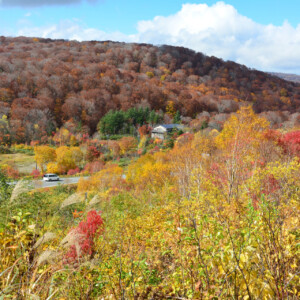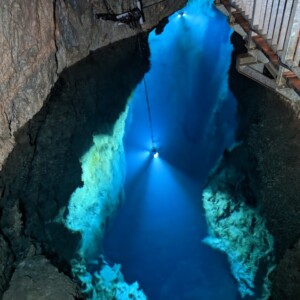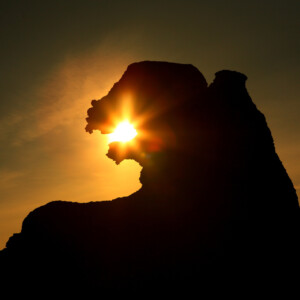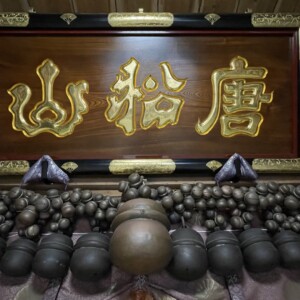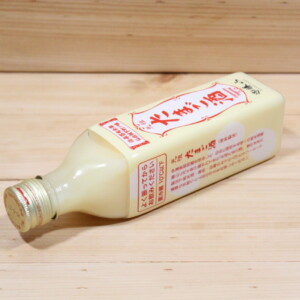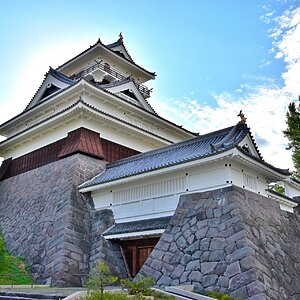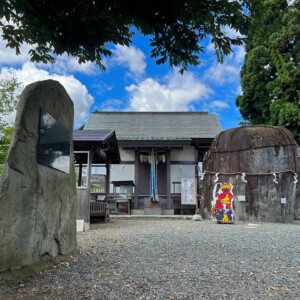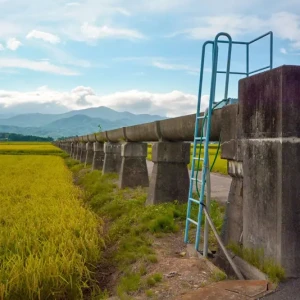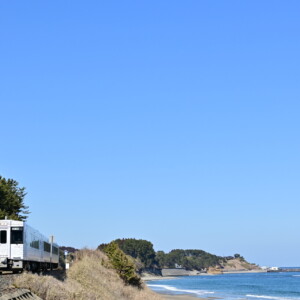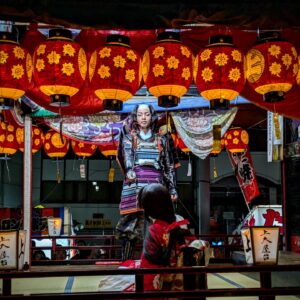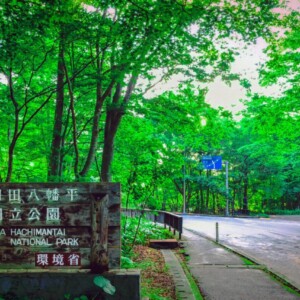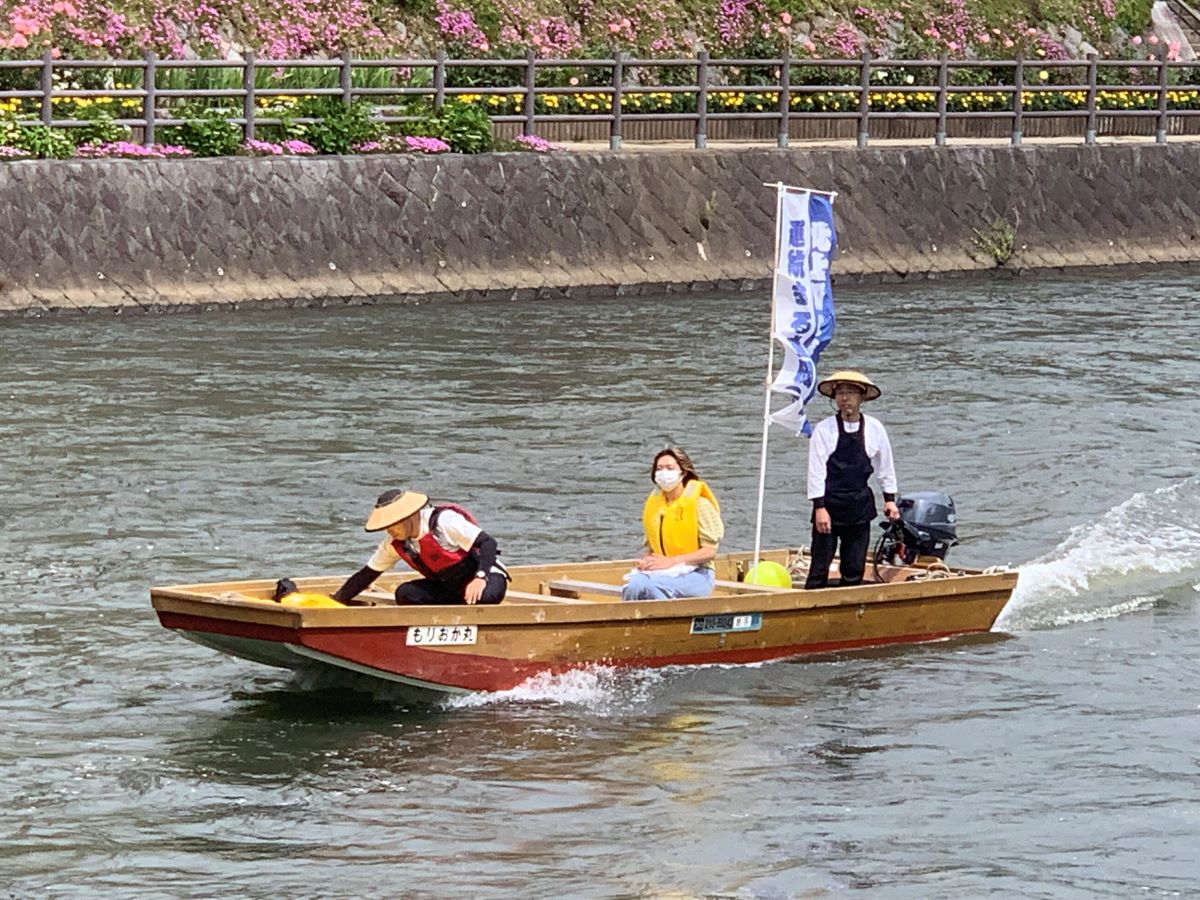
New Morioka specialty! I tried riding the Kitakami River boat transport experience attraction "Moriokamaru"! [Iwate Prefecture]
table of contents
- 1 What kind of ship is the Morioka Maru?
- 2 Departure from Morioka Port in Kibuse Green Space
- 3 Zaimokucho Riverside Stone Wall and Mitsuharasha Shrine
- 4 Asahi Bridge - Kaiun Bridge - Furukata Bridge
- 5 Rapids Under the Willows
- 6 Mikawa confluence
- 7 Shinzankashi
- 8 Reservations for the Morioka Maru can be made through the official website
- 9 summary
Morioka is a "river town" where three rivers, the Kitakami River, the Shizukuishi River, and the Nakatsugawa River, converge. During the Edo period, rice tax was transported to Edo via Ishinomaki by boat on the Kitakami River, but boat transport eventually declined with the advent of the railway
The Morioka Association for Operating Boats on the Kitakami River was established with the hope of reviving this boat culture, and for the past two years has been operating the Morioka Maru as a limited-time river opening event for boat transport on the Kitakami River
You can enjoy a 2km river cruise from Kibushi Green Space near Morioka Station to the foot of Meiji Bridge downstream
What kind of ship is the Morioka Maru?
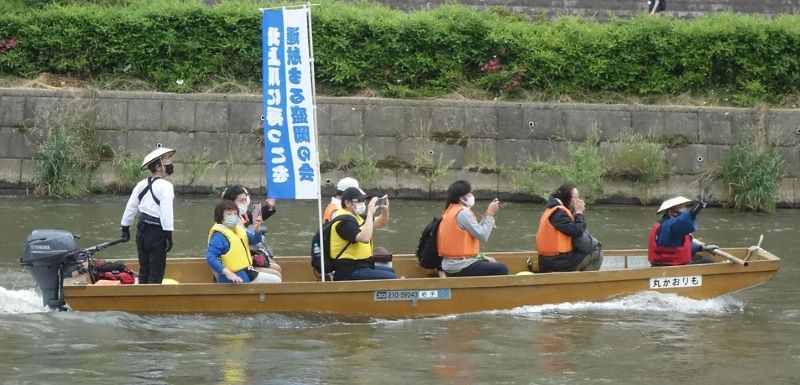
The Morioka Maru is a wooden ship called a Hirata-bune, built by Kesen carpenters in the coastal city of Rikuzentakata
The boat can accommodate up to 10 people, and the captain who operates the outboard motor and the boatman who sits at the bow ensure safe operation and also act as guides at key points
There are other wooden and FRP boats as well, but the Morioka Maru is the main attraction on this route
Departure from Morioka Port in Kibuse Green Space
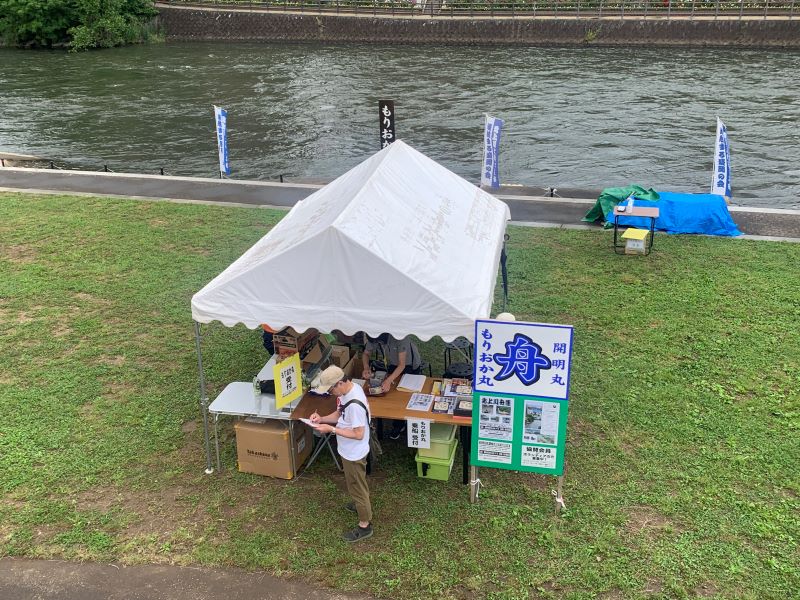
Morioka Port, from which the Morioka Maru departs, is located in Kibuse Green Space on the Kitakami River riverbed, close to Morioka Station. Here you can complete boarding procedures and receive instructions on how to put on the loaned life jackets and other precautions to take when boarding
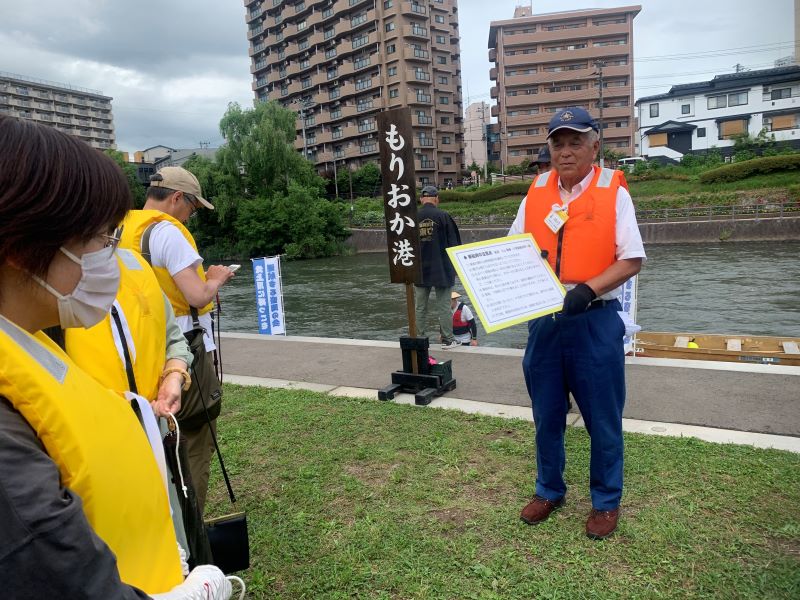
On the bank of Kibuse Green Space, there is a group of shops that opened in September 2019, including restaurants such as gelato shops, cafes, craft beer shops, and izakayas
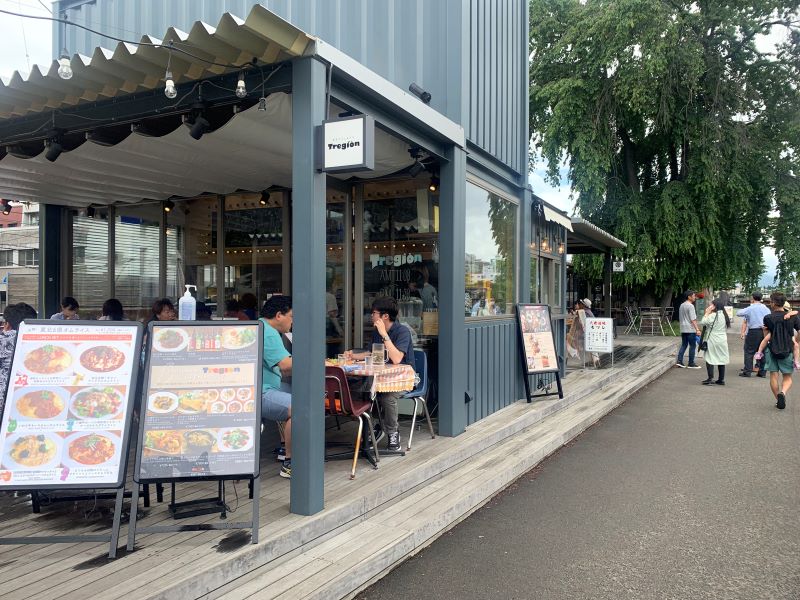
We recommend spending some time here enjoying the river breeze before your departure

After departing from Morioka Port, you will first go up the river and pass under Asahibashi Bridge. Take this opportunity to take a closer look at the structure underneath the bridge, which you normally cross without giving it much thought
Zaimokucho Riverside Stone Wall and Mitsuharasha Shrine

The bank on the right hand side upstream from Asahi Bridge is called Zaimokucho a "Yoichi" market is held here, bustling with a variety of stalls selling seasonal vegetables, fruits, flowers, seafood, as well as homemade bread and local beer.
The name Zaimokucho comes from the fact that there were many lumber merchants here when shipping by boat was popular , and stone walls believed to have been built by these merchants and stairs leading down to the riverbank can be seen from the river.
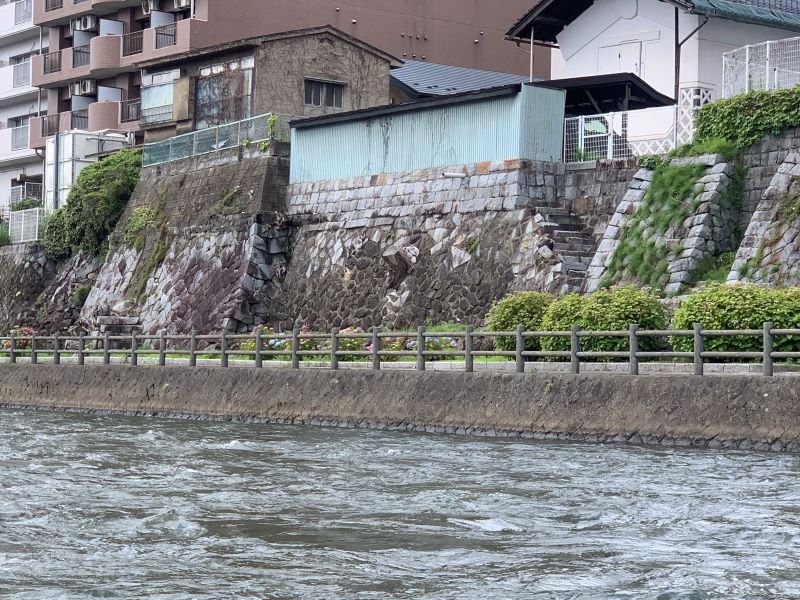
This stone wall has been designated as a preserved structure by Morioka City as the "Zaimokucho Ura Ishigumi"
Mitsuharasha , located in Zaimokucho the publisher that published Miyazawa Kenji's only children's story, "The Restaurant of Many Orders," but at the time there were few orders for this story and it barely sold.

Nowadays, the shop operates as a folk craft store, selling lacquerware, a specialty of Iwate, but it also houses a Kenji museum on the premises and continues to cherish its connection with Kenji
Asahi Bridge - Kaiun Bridge - Furukata Bridge
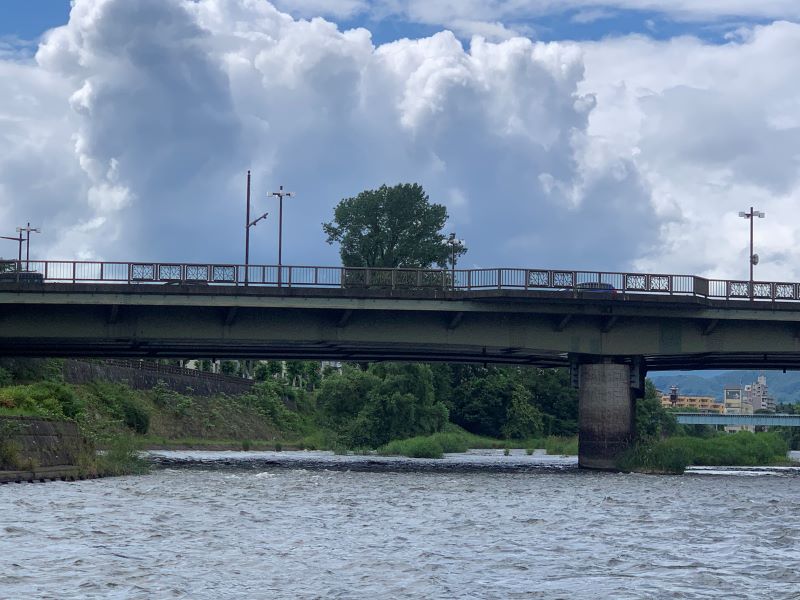
The Morioka Maru, which had been sailing up the river with Mt. Iwate directly in front of it, makes a U-turn just before Yugaose Bridge and heads down the river

We pass under Asahi Bridge again, in front of Morioka Port, and are seen off by staff. Kaiun Bridge, also known as the "Twice Crying Bridge," comes into view.
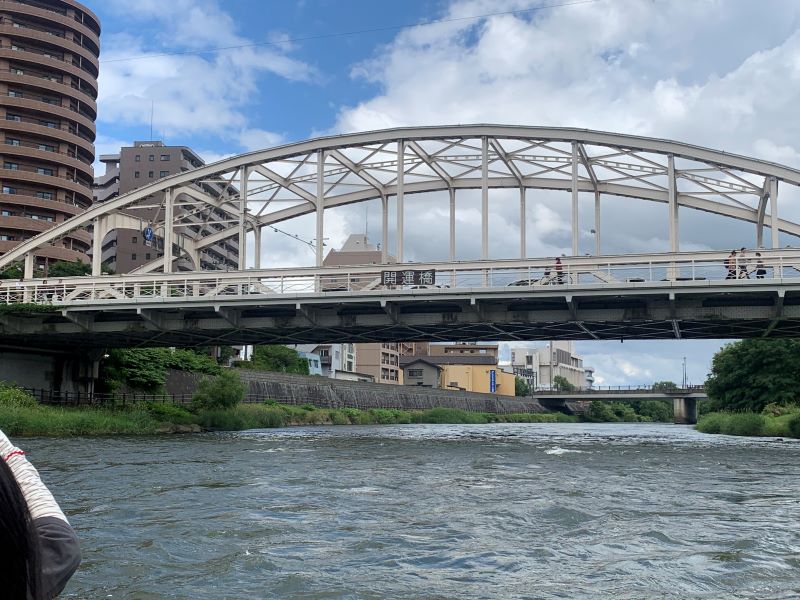
It is said that when transferees cross this bridge, which leads to Morioka Station, they cry once, saying, "I've come to a faraway place," and then when they cross it to leave Morioka for their next transfer, they cry a second time, sad to be leaving Morioka, a city with such warm-hearted people .
The next bridge, Kozukatabashi, opened in 2006 and is the newest of the Kitakami River bridges in Morioka City.With seven lanes in both directions, this wide bridge has made it easier to travel between the lower bridge and Morioka Station
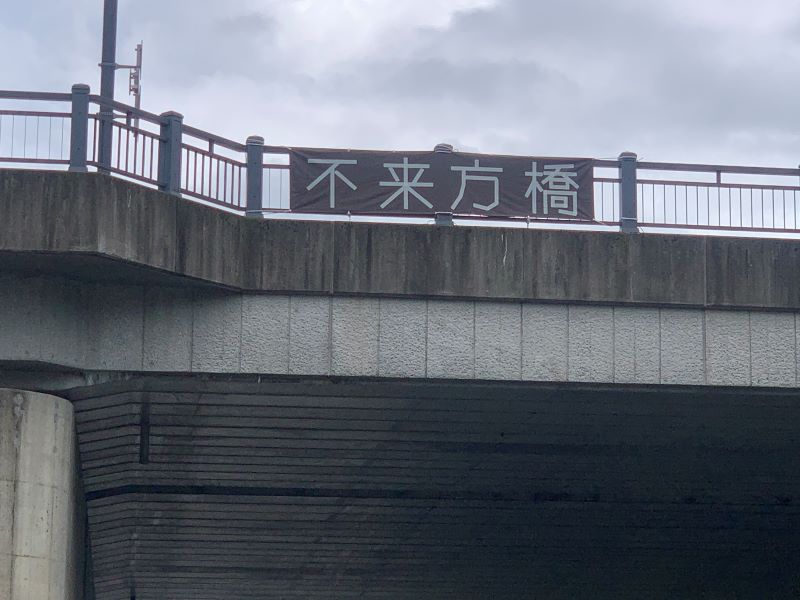
A banner with the name of the bridge is hung on the railing of the bridge under which the Morioka Maru passes. This banner was handmade by the operators using duct tape and other materials, and is only displayed when the ship is in operation
Rapids Under the Willows
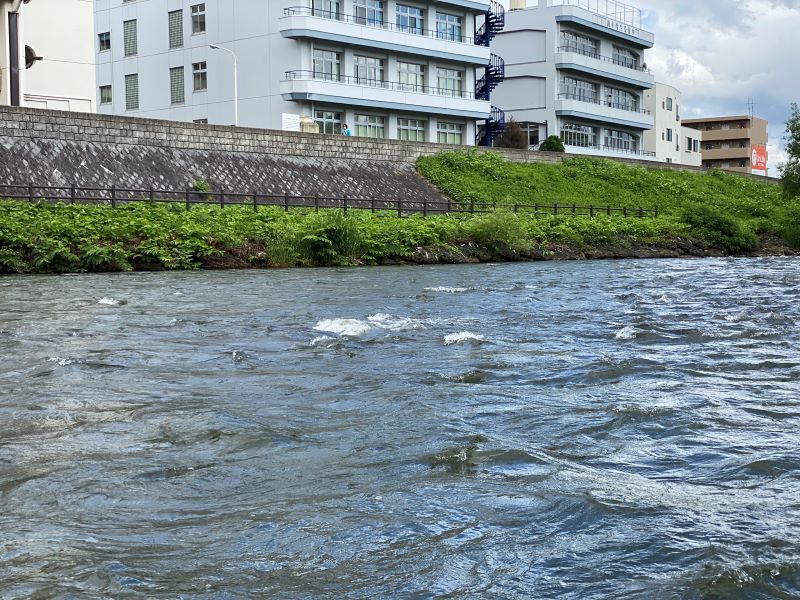
"The soft willows blooming on the banks of the Kitakami River make me want to cry."
Ishikawa Takuboku, a native of Iwate Prefecture , wrote this poem while living in Tokyo, imagining the green willow trees sprouting along the banks of the Kitakami River and feeling homesick.
Willow trees hang down along the shore beyond Furukata Bridge, which overlaps with the scenery described in the song, but from here the river narrows and becomes a rapid, and contrary to the melancholic song, large waves form on the river surface, causing the boat to rock

The captain's skillful maneuvering takes the Morioka Maru down safely, but the river surface swirls and splashes, making for a thrilling little ride down the river
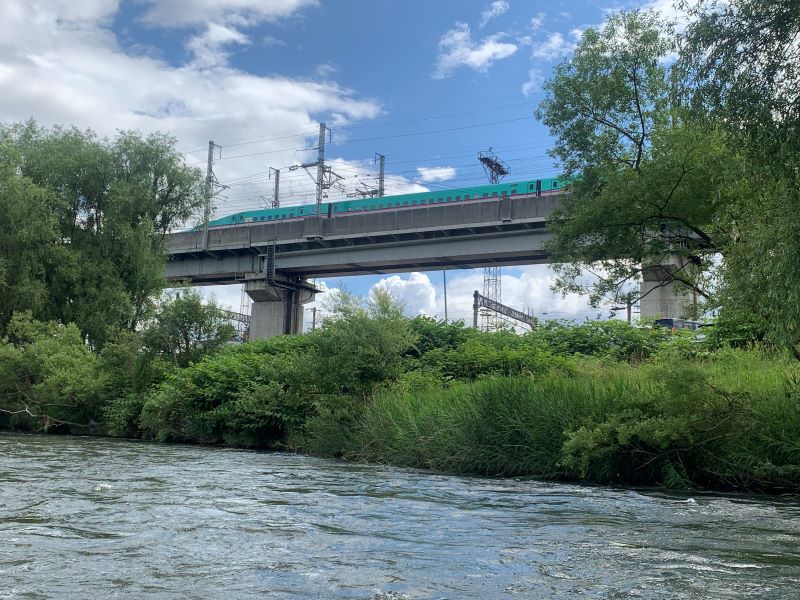
Once you have safely passed the rapids under the willow trees, you will see the spacious Kitakami River Park on the riverbed to your left, and the railway bridges of the Tohoku Shinkansen and Tohoku Main Line to your right. If you're lucky, you might even see the Hayabusa or Komachi trains
Mikawa confluence
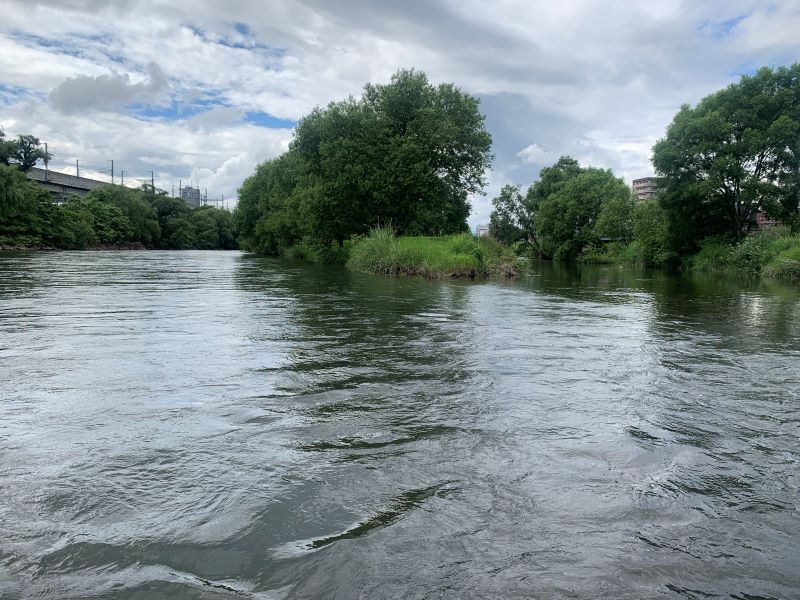
As the rapids become gentler and the river widens, it reaches the confluence of three rivers: the Kitakami River, the Shizukuishi River, and the Nakatsugawa River
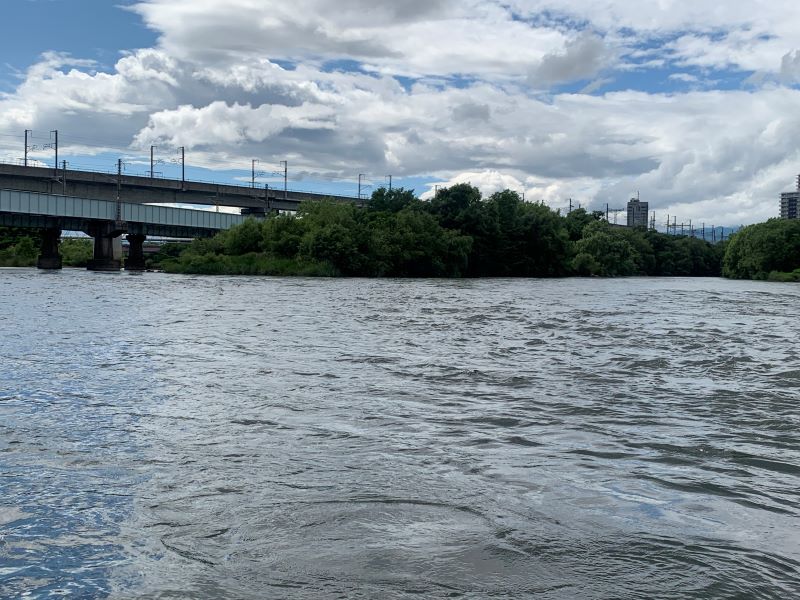
The three rivers all have their sources within the vast Iwate prefecture: the Kitakami River from a spring in Iwate Town north of Morioka City, the Shizukuishi River from the foothills of Mt. Akita-Komagatake on the Iwate side of the Akita border, and the Nakatsugawa River from the Kitakami Mountains west of Morioka

When we reach this point, the boat captain will turn the Morioka Maru upstream several times so that we can view the confluence from downstream and enjoy watching the water volume of the Kitakami River increase and grow even more as the two rivers merge
Shinzankashi
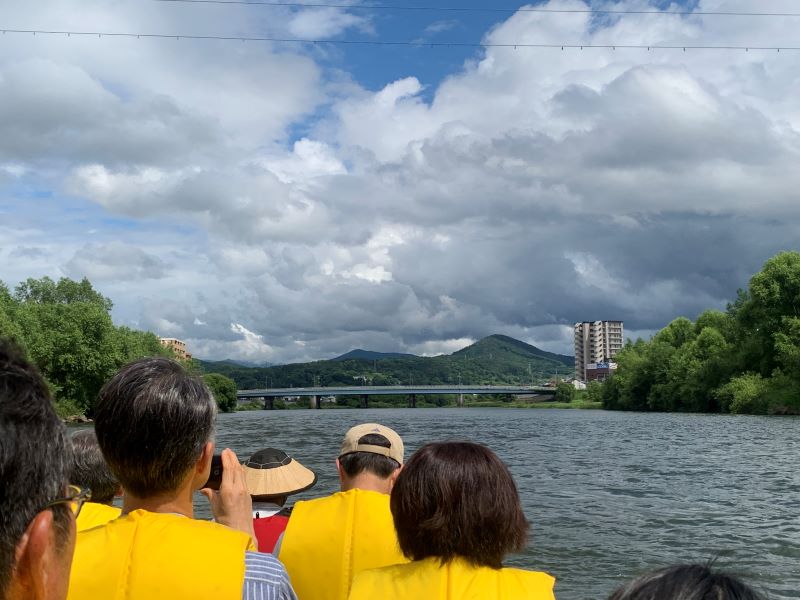
After passing the confluence of the three rivers, the river becomes wider and the flow becomes gentler. Meiji Bridge, which spans the old Oshu Kaido road, comes into view directly ahead, and at the foot of the left bank is Shinyama-kawashi, the terminus of the river
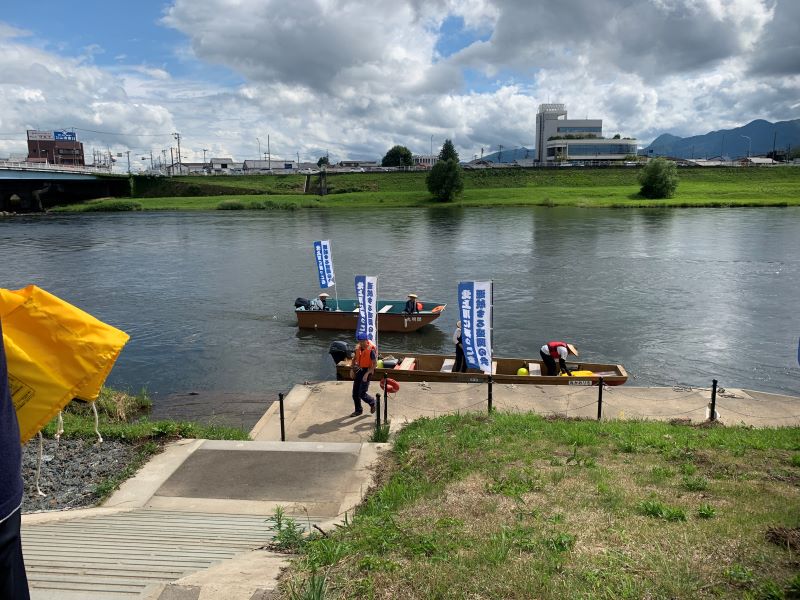
Shinyamagashi is the starting point of boat transport on the Kitakami River and the entrance to Morioka Castle.It is located a little downstream from the current bridge, along with Meiji Bridge, which was a pontoon bridge until the early Meiji period.The remains of the former bridge sandbar and rice storehouses used for boat transport remain.
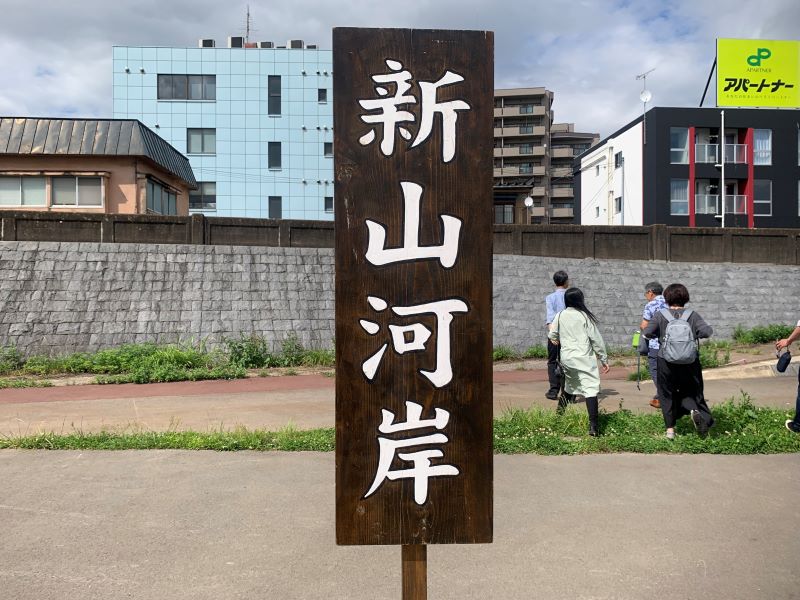
There are no return flights from here to Morioka Port, so it is a one-way trip, but the surrounding area is full of old streets and temples known as Nataya-cho, so why not take a leisurely stroll through its tranquil atmosphere?
If there are other events taking place, a shuttle bus may run to Morioka Station, so it's a good idea to check the official website
Reservations for the Morioka Maru can be made through the official website
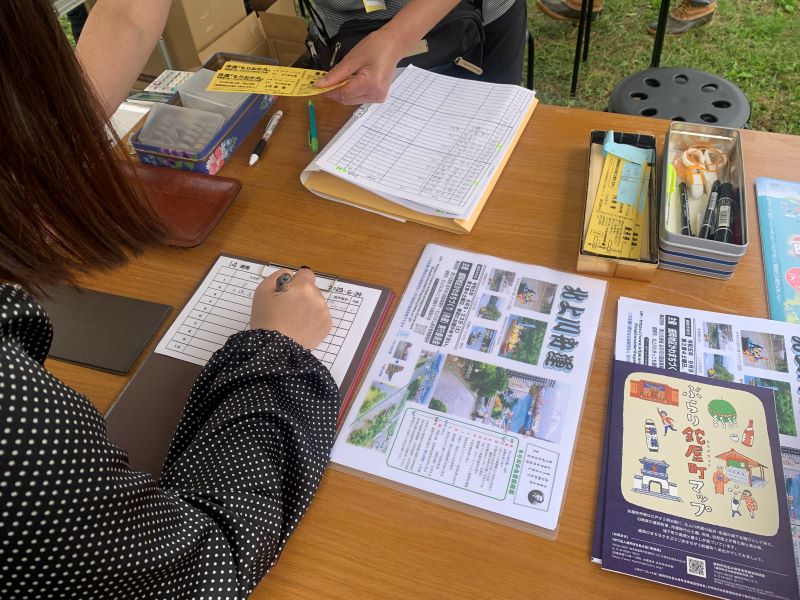
Reservations for the boat ride can only be made through the official website of the Morioka Association for Boat Operations on the Kitakami River
As of July 1, 2023, the fare is 1,500 yen for adults one way (750 yen for children aged 4 and over and under junior high school students; children under elementary school age must be accompanied by an adult), and is paid in cash at the boarding reception
There will be four to five trips operating on Saturdays during the river opening period, but operations for the first half of 2023 have ended and reservations are currently being accepted for September 9th, September 23rd, and October 7th
You can board the boat with carry-on luggage such as a backpack
Kitakami River Boat Transportation <Information>
- Event name: Kitakami River Boat Transport
- Organized by: Morioka District River Town Development (Boat Transport) Executive Committee
- Member organizations: Iwate River and National Highway Office of the Ministry of Land, Infrastructure, Transport and Tourism, Kitakami River Dam Integrated Management Office,
Morioka City, Morioka Association of Boat Operators on the Kitakami River - Official URL: Morioka Association of Boat Operators on the Kitakami River Official Website
- Email:mulder@agate.plala.or.jp
Google Map
summary
Until now, the only thing people would talk about when talking about river rafting on the Kitakami River was the rubber boat river rafting competition held every summer, but it is now starting to be recognized as an attraction where people can enjoy river rafting on a shorter distance and more casually
When people walking along the riverbank or crossing the bridge see the Morioka Maru, they wave, and it's nice to see them wave back, feeling a kind of bond that only comes once in a lifetime
Why not give it a try?


![[Iwate Prefecture] 7 famous waters in Iwate Prefecture! Sweetfish and salmon swim upstream in the famous water that flows through the city! Kanazawa Seisui](https://jp.neft.asia/wp-content/uploads/2023/01/04c0e41c5c967dc6dff186747fcc80df-150x150.jpg)
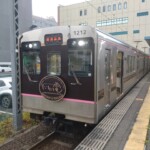
![[Morioka City, Iwate Prefecture] 3 recommended sake restaurants where you can enjoy the locally loved Morioka! Morioka Odori](https://jp.neft.asia/wp-content/uploads/2023/06/4ee1c80dc8464d159d46f68c2c2f2997-150x150.jpg)
![The specialty of Genbikei, "Flying Dango," is definitely worth a visit! Delicious activities! [Ichinoseki City, Iwate Prefecture] Genbikei bus stop](https://jp.neft.asia/wp-content/uploads/2017/04/IMG_5931-150x150.jpg)
![Bottle Don is the definitive Sanriku souvenir that looks delicious! [Iwate Prefecture] Bottle don (abalone, scallop, salmon roe)](https://jp.neft.asia/wp-content/uploads/2023/06/IMG_5048-150x150.jpg)
![Ryusen-no-no-no-no-no-no-no-no-no-no-no-no-no-no-no-no-no-no-no-no-no-no-no-no-no-no-no-no-no-no-no-no-no-no-no-no-no-no-no-no-no-no-no-no-no-no-no-no-no-no-no-no-no-no-no-no-no-no-no-no-no-no-no-no-no-no-no-no-no-no-no-no-no-no-no-no-no-no-no-no-no-no-no-no-no-no-no-no-no-no-no-no-no-no-no-no-no-no-no-no-no-no-no-no-no-no-no-no-no-no-no-no-no-no-no-no-no-no-no-no-no-no-no-no-no-no-no-no-no-no-no-no-no-no-no-no-no-no-no-no-no-no-no-no-no-no-no-no-no-no-no-no-no-no-no-no-no-no-no-no-no-no-no-no-no-no-no-no-no-no-no-no-no-no-no-no-no-no-no-no-no-no-no-no-no-no-no-no-no-no-no-no-no-no-no-no-no-no-no-no-no-no-no-no-no-no-no-no-no-no-no-no-no-no-no-no-no-no-no-no-no-no-no-no-no-no-no-no-no-no-no-no-no-no-no-no-no-no-no-no-no-no-no-no-no-no-no-no-no-no-no-no-no-no- [Iwate Prefecture] Ryusendo Cave (first underground lake)](https://jp.neft.asia/wp-content/uploads/2023/07/PXL_20230512_052246926.NIGHT_-150x150.jpg)
![[Series ②: The role of the previous nine years and the role of the second three years] The role of the previous nine years is from the truce to the battle again, and the Kokufu army is struggling Taga Castle Ruins](https://jp.neft.asia/wp-content/uploads/2023/11/a0b8b1213124e7a13c7308fa81e053a2-150x150.jpg)
![[Iwate Prefecture] Soft-serve ice cream with sake, miso and wasabi flavor! Why are the soft serve ice cream eaten at roadside stations so delicious? There's also school lunches! Iwate Prefecture Catch](https://jp.neft.asia/wp-content/uploads/2025/06/915fd0ce722ab0f21e74864401170847-150x150.jpg)

